Students Repairing the World Through Science and Imagination
What will the refrigerator of the future be like? Twenty-eight years ago, a group of second graders explained that the refrigerator would not have a door that you opened but rather a compartment where you placed food to go into the fridge and where you would remove food from the fridge. Food would automatically be placed inside in the most energy efficient way. It would keep track of the foods and if any food spoiled, it would be rejected. The refrigerator would have a display showing what foods were available. It would tell you the meals you could make with the foods you have. You would have to identify yourself when you requested foods. If you asked for a cupcake, the refrigerator might respond, “Wouldn’t you rather have a carrot?” Certainly a 2nd graders’ perspective!
This was a winning entry in the Toshiba/NSTA ExploraVisions competition. Each student on the team received a $10,000 prize and a trip to Washington DC with their teacher and parents. While in DC, they met their congressman, toured the Capital, visited the zoo, and presented their winning entry at the National Press Club. They were special guests at a gala celebration where their success was celebrated. They met George Takei (Mr. Sulu of the original Star Trek) and got to pop the balloons of a twenty-foot replica of the Starship Enterprise.
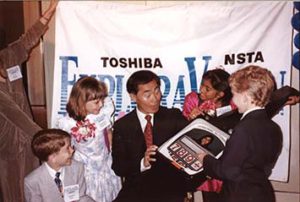
These second graders are now in their thirties. They have graduated from college and have exciting careers and lives. Some have children of their own. They all remember their refrigerator of the future and the recognition of their efforts.
As we embark on the thirtieth anniversary of ExploraVisions, your students can also creatively explore what a technology may be like twenty years from now. Participating in the competition will meet many of the guidelines of good science instruction as outlined in the Framework and the Next Generation Science Standards as well as merging science, engineering, technology and creativity as students work in teams.
EXPLORAVISION COMPETITION GUIDELINES
Student teams entering the competition identify a present technology of their choosing. It can be a car, a phone, money, an umbrella, or anything that captures their interest. They then describe how the technology is presently used and what its features are. They then provide an historical summary of this technology which may include inventors of the past and adaptations of the technology over the years. This is the easy part of the entry. It teaches research skills, teamwork, and helps the students see how technology can assist in solving some problem or make something that humans would like to do easier, faster, or cheaper. The students must then describe their vision – what will this technology be like twenty years in the future. Predictions require creativity but must also be constrained by science. We ask students to ground their vision by having them describe the breakthroughs in science and engineering that will be required to make their vision a reality. Identification of these breakthroug’s help students to recognize why we cannot have their technology today and why we don’t have to wait one hundred years for it.
High quality engineering education requires students to not latch on to their first idea but to consider other ideas as well. We have students inform us of their design process. What decisions did they make in coming up with their “refrigerator of the future,” for example? Did they consider having many compartments? Did they decide on the position of the compartment for ease of use by children and adults? Did they have the person typing in requests on the door or speaking to the door? Student engineers make many of these decisions. Having students record these decisions is part of the engineering design cycle and supports their engineering learning.
Breakthroughs in science and technology do not just happen miraculously. Students are asked to tell us about one science experiment that must be completed to make their vision a reality. For example, how will the “refrigerator” recognize when food has spoiled. How will the scientists who help create this refrigerator conduct experiments to determine if food is spoiled? Is the test for milk or fruit or cheese or bread different? Students map out the experiment; they do not have to conduct the experiment.
All technologies have both positive and negative consequences. Most people love their smart phones, but some cannot get away from work on weekends because of the incessant texts and emails. Most people love their cars but cannot put up with the traffic and pollution that accompanies this great technological marvel. In their ExploraVision entry, the student team must identify both the positive and negative impacts of their technology in the future. Generating a list of positive consequences seems relatively easy for our students. Negative consequences require more analysis. In the “refrigerator of the future,” the students listed positive consequences as energy savings, better health, and ease of use. For their negative consequence, they explained that, with all the dials and displays on the front of the fridge, there would be no place to hang up their artwork or report cards. Wow!
No idea, regardless of how good it seems, can be disseminated without some communication skills. Students complete their ExploraVision entry by sharing their vision with an outline of five web pages.
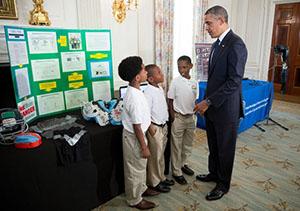
All STUDENTS ARE WINNERS
Every year for the past twenty-nine years, an average of nearly 15,000 students (K-12) have completed all the entry requirements and submitted group ExploraVision projects. They are all winners and are recognized as such. In addition to the positive learning experiences, all students receive a certificate from NSTA as well as a small gift. The top 10% of entries are recognized as Honorable Mentions and receive a larger gift. Twenty-four teams are deemed finalists and receive electronic equipment to help them with developing their websites. Each member of the winning teams receives a $5,000 or $10,000 savings bond and the trip to Washington DC. The rules of the competition are nearly identical for all K-12 students, but the elementary school children do not compete against the high schoolers. The entries are judged in four categories K-3, Grades 4-6, Grades 7-9, and Grades 10-12.
Some teachers in K-3 or 4-6 have the students complete their entries as part of their class instruction. Others offer the projects as extra credit. Each team is allowed to have a parent or neighbor serve as a mentor. The mentor support can be beneficial for after-school work on the projects.
The two 2021 team winners in the K-3 category were a toothbrush and a lung transplant. Winners in the Grades 4-6 category in 2021 were a method of decomposing plastics and a water filtration system. The winning entries are posted on the website. Some details of these winning entries will be used to illustrate how involvement in ExploraVisions supports strong science and engineering learning.
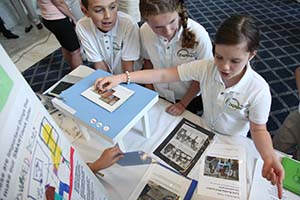
FRAMEWORK AND NGSS
The vision of the Framework has as its first goal to educate all students in science and engineering. Details of how to accomplish this is outlined in the Framework and further articulated in the Next Generation Science Standards. We all strive to apply three-dimensional learning to all our lessons where students gain experiences with the disciplinary core ideas (DCI) and the crosscutting concepts (CCC) and the science and engineering practices (SEP). Having students participate in the Toshiba/NSTA ExploraVisions competition supports this three-dimensional learning while also dealing with embedded aspects of curriculum such as the Nature of Science and Engineering Design which are found in the Appendices of the NGSS document.
When student teams begin to identify the technology that they will focus on for ExploraVision, they are surveying many of the disciplinary core ideas (DCI) of the Framework. The choice of the DCI is based on student interest. Although aspects of their project may have to do with energy or forces or adaptation, they are not locked into the constraints of the DCI for their grade level. Often, we find that students uncover topics that are found in the secondary school DCIs and students rise to the challenge of learning about this content as it relates to their technology. Students also find that their topic of choice requires them to learn about DCI from more than one disciplinary area (e.g. physical sciences and engineering; physical science and life science.) For example, the K-3 winning team explored lung transplants which required them to learn about lung membranes, stem cells, rejection of organs, alveoli, and biodegradable artificial micropumps. Their initial exposure to this range of topics will provide a good foundation for further study as they progress through school and college.
Engineers begin with a problem. Our student engineers in ExploraVision begin with a problem as well – how is this present technology deficient? What improvements would be valued? Defining the problem (engineering) often pushes them to ask questions (science). For example, both K-3 winners this year began with students looking at problems related to Covid-19. One problem was the increase in respiratory issues due to Covid and their solution was lung transplants. The other was the problem of Covid-19 testing and their realization was that a toothbrush may be able to test for the virus every day (and also test for gum disease and other ailments.) Asking Questions and Defining Problems is the first of the Science and Engineering Practices in the Framework. Other Practices were present in the entries as well.
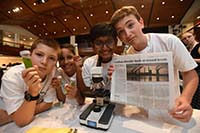
“Some important themes pervade science, mathematics, and technology and appear over and over again…” (AAAS- Benchmarks). Some of these Crosscutting Concepts are reinforced in student essays. For example, all ExploraVision projects focus on “structure and function” whether it has to do with objects or living things. Optimizing any technology requires recognizing how the structure and function are dependent on each other. In our winning Grade 4-6 entry on water filtration systems, students focused on breakthroughs in solar powered batteries, development of a plastic-eating microbe and inventing a natural coagulant.
Given the complexity of developing and adopting good curriculum with three-dimensional learning, it is easy to forget that there are additional elements of science and engineering learning that fit within these dimensions but are explained in the Appendices of NGSS. Appendix I – Engineering Design in the NGSS – articulates the engineering design cycle and illustrates how students in elementary schools should become familiar with it and how it should be regarded as the same importance as inquiry learning. It seems almost obvious that students working on their ExploraVision projects Define, Develop Solutions and Optimize. They identify problems and set criteria for solutions. They research possible solutions and identify advances that will be required for those solutions.
Similarly, Understanding the Scientific Enterprise: The Nature of Science – reminds us that science is a way of explaining the natural world and that neither science nor technology are static. Advances in technology allow for new scientific insights. Conversely, new scientific questions require new technologies and instruments. This interplay of the natural and material world is present in all ExploraVision projects.
ADVICE FROM OTHER TEACHERS
“One of the biggest lessons I have learned by coaching more than 50 ExploraVision teams over the past five years is to never underestimate the creativity of students. The innovations proposed by my students never cease to amaze me. As their coach, I really let the teams take the lead and solely work to assist them with time management and meeting deadlines and breaking down the project into smaller parts. As a teacher, ExploraVision has provided me with the opportunity to establish meaningful relationships with my students and has allowed me to witness their love of science and learning.
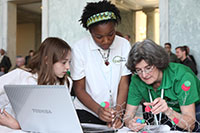
“I’ve been involved with ExploraVision for over 10 years. The value of ExploraVision doesn’t just lie in the academic knowledge gained in the sciences. Its primary benefits are the investigative skills that students learn. Skills that are critical to success as a research scientist, but also as an educated and aware citizen of an ever-changing global world. Of the many skills this opportunity provides, there are three that stand out – creativity, critical analysis, and collaboration.”
Other teachers have also shared what they consider are positive features of having students work on ExploraVision:
- Technical writing and research skills.
- Deep dives, and a self-driven student learning experience.
- Collaboration and critical thinking
- Building teamwork skills
- Investigating real world problems and finding solutions.
- The biggest is that there is no limit to what they can imagine- the future holds any they can think of! I love the freedom of ideas!”
- They had the opportunity to practice our school success standards (gather & org info, solve complex problems, defend thinking w/ evidence).
- Opportunity to develop skills in creativity, collaboration, critical thinking, communication, character, citizenship and research.
- Collaboration and Creativity
- The opportunity to apply science to make positive change in the world.
- My students thrive with Exploravision! They become active participants in the learning process engaging in brainstorming and researching possibilities for future discoveries.
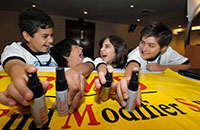
CONCLUSION
Participation in ExploraVision provides all our students with the opportunity to think about being an engineer or a scientist. Science is about wondering, investigating, and questioning. ExploraVision is a creative endeavor. As students think about a future technology, they are dreaming about their future. As they describe the breakthroughs that their project requires, some students discuss how scientists will do this and engineers will do that. Other students use the first person – I will do this, and my partner will do that. Students learning about science and engineering and seeing themselves in a future that is better than the present is a gift of optimism and hope that we can instill in our students.
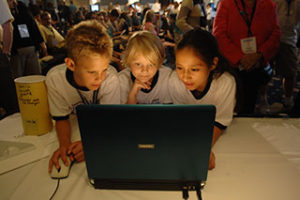
Author Arthur Eisenkraft, PhD is a co-founder and head judge of the ExploraVision program and Distinguished Professor of Science Education; Director of the Center of Science and Math in Context (COSMIC), College of Education and Human Development.
To see a full article, please visit here.